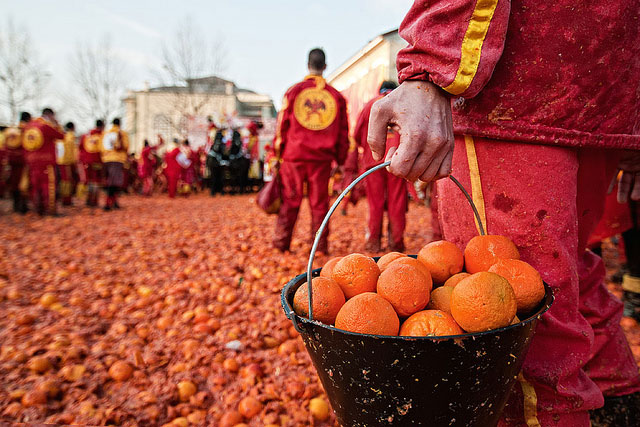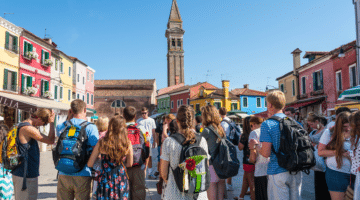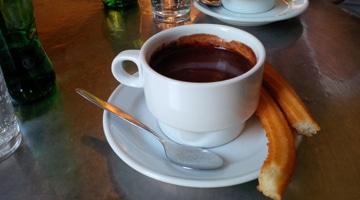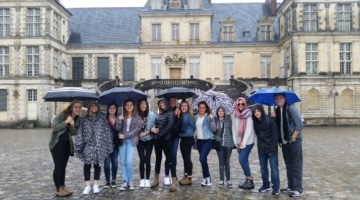When Traveling to Italy During Carnavale, Watch Out for Flying Oranges

This blog post was written by ACIS Tour Manager, Giacomo Gambone.
I bet most of you have memories of a Carnival. Lived in first person or just seen on tv. What is Carnival generally associated with? Masks in Venice, dancers in Rio, floats in Viareggio, beautiful costumes in Notting Hill. Everything related to a carnival brings out memories of joyful fun, not battles, fights or…oranges.
Well, in Ivrea, the town I live in, Carnival equals all of the above. In this beautiful town, founded by Romans (like 99.9% of cities in Italy, so not such a jawdropping info…) we fight with oranges to celebrate our freedom from the cruel tyrannus.
It throws back its history in the Middle Age, when the city was ruled by the cruel Arduino, a tyrannus that imposed the “ius primae noctis” rule to this piece of land. Basically, he slept with any bride on the first night of marriage. One night, the population started its rebellions when the proud MUGNAIA, the daugher of a millman, after having slept with him, cut his head off. Showing with pride the head to the people from the balcony of Arduino’s castle, the rebellion started.
Of course the tradition hasn’t been kept alive since then. It was Napoleon (or some of his ministers) that gave new life to it. This year will be the 205th of the festival. The carnival is hence the representation of that momentum, an allegory brought to life during the French dominion on Canavese and Ivrea. A dominion that changed many aspects of the everyday life. For example, the main crop in the area, that changed from olive oil to wine.
The battle nowadays still represents the fight between the people and the defensors of Arduino, the latter throwing oranges from carts. The “walking fighters,” so-called aranceri, represent the people, and are divided into nine teams, that don’t strictly represent any neighborhood (with the exception of the Tuchini). Above them all, of course, the Mugnaia, the main character in this fictional but “RELIGIOUS” representation. She must be a married woman from the town’s elite (everytime I say this it makes me chuckle, but that’s how it is!).
Here’s a list of the teams of aranceri and a brief description:
Asso di Picche, the oldest team. Founded in 1947. Before them, people used to throw oranges “independently.” Colours: red and blue, with a black ace of spade (the translation of asso di picche). They also have little bells sewn to the trousers. So you can hear them coming.
Aranceri della Morte, the death’s aranceri! The creepiest name for a great team founded in 1954. Colours: black and red, of course!
Tuchini del Borghetto. Great team, they throw oranges in the old medieval neighbourhood, the Borghetto. Colours: green shirt and red trousers.
Scacchi. The word means chess, so they wear a black and white squared shirt with an orange tower on the back. The orange tower refers also to the Castle of Ivrea, that has four red towers.
Scorpioni di Arduino. The only team that refers to the tyrannus! In fact, very conservative people are part of it. I personally don’t like them very much! Colours: bright yellow shirt and green trousers.
Pantere. The “black panthers.” No, nothing to do with Malcolm X here. The team was very popular in the 70s, but it’s still an important part of the show. Colours: black shirt and black trousers with a yellow stripe on the side.
Diavoli. The devil’s fighters. Fierce rivalry with Scacchi, they pride themselves for their “fighting organization” (ok, it sounds ridiculous. It is a bit, ridiculous!) Colours: red shirt and red trousers, with a yellow stripe on the side.
Mercenari. “The mercenaries” are a good team, that cares more about drinking and getting high than fighting. That’s why I like them. They share the piazza with the super-organized Diavoli, in a very funny “neighbours war.” Colours: purple shirt and yellow trousers.
Credendari. By far the smallest team, but the youngest. If you want to fight and you’re looking for the “business class” with more room and more comfort, go with them in their square. Colours: blue shirt and yellow trousers.
So, it is a fantastic show to see! You can safely protect yourself behind the nets placed in each piazza where the battle takes place (the fighting zones are strictly respected) and don’t forget to bring or to buy a red hat. It is the “neutrality” signal. If you wear it, it means that you’re just there to enjoy the show. If you don’t wear it, expect to go back home smelling like marmelade as everyone will be throwing oranges at you.
Giacomo Gambone is an Italian ACIS Tour Manager working in Italy, France and Spain. He is passionate about food; his family produces wine and olive oil in Piedmont and Sicily. He hails from the Turin area and he is currently based in London. [Image source: Mario Tarello]










